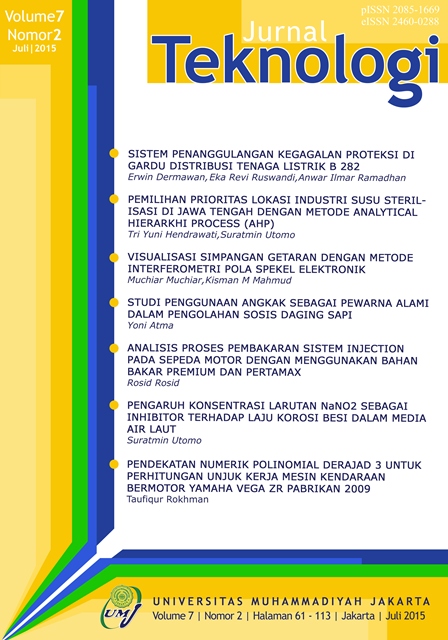PENDEKATAN NUMERIK POLINOMIAL DERAJAD 3 UNTUK PERHITUNGAN UNJUK KERJA MESIN KENDARAAN BERMOTOR YAMAHA VEGA ZR PABRIKAN 2009
Main Article Content
Abstract
Downloads
Article Details
COPYRIGHT POLICY
The author(s) of an article published in the Jurnal Teknologi retains ownership of the intellectual property rights in work (s).
PUBLISHING RIGHTS
The author(s) of an article published in the Jurnal Teknologi have unrestricted publication rights. The authors give the Jurnal Teknologi the right to publish the article and designate the Faculty of Engineering Universitas Muhammadiyah Jakarta Publishing as the original publisher of the article.
LICENSING POLICY
Journal of Mechanical Engineering and Sciences is an open-access journal that follows the Creative Commons Non-Commercial 4.0 International License (CC BY-NC 4.0), which states that:

Under this license, the reusers must give appropriate credit, provide a link to the license, and indicate if changes were made. Users may do so in any reasonable manner, but not in any way that suggests the licensor endorses users or their use.
Please take the time to read the whole license agreement (https://creativecommons.org/licenses/by-nc/4.0/). As long as reusers follow the license conditions, the owner cannot withdraw these freedoms. The following components are included under this license:
 Attribution: Users must provide appropriate attribution, including a link to the license, and indicate whether or not they made any modifications. Users are free to do so reasonably, but not in a manner that indicates the licensee approves of their usage.
Attribution: Users must provide appropriate attribution, including a link to the license, and indicate whether or not they made any modifications. Users are free to do so reasonably, but not in a manner that indicates the licensee approves of their usage.
 NonCommercial: Users may not use the material for commercial purposes.
NonCommercial: Users may not use the material for commercial purposes.
References
Heywood, John, Internal Combustion Engine Fundamentals, McGraw Hill International New York
Winther, J.B, Dynamometer Handbook of Basic Theory and Aplications, Cleveland,Ohio:Eaton Corporation.(1975)
Wark Kenneth, Jr. 1992, Thermodynamics, McGraw Hill International New York
Martin, George H, 1982, Kinematika dan Dinamika Teknik, Erlangga, Jakarta
Sularso, 2008, Dasar Perencanaan dan Pemilihan Elemen Mesin, Pradnya Paramita, Jakarta
Daryanto, 1985, Ikhtisar Praktis Teknik Mesin, Tarsito, Bandung
Jl Meriam, L Krige, Tjahjana Adhi, Subagio, 1993, Mekanika Teknik Dinamika, Erlangga, Jakarta
C.Chapra, Steven, 1988, Metode Numerik, Erlangga, Jakarta
Munir, Rinaldi, 2008, Metode Numerik, Informatika, Bandung
R. Tooley, John, 1986, Numerical Methods in Engineering Practice, Holt Rinehart And Winston, Inc, Newyork
Awad S. Bodalal, Sayed A. Abdul_Mounem, Hamid S. Salama, 2010, Dynamic Modeling and Simulation of MSF Desalination Plants, Jordan Journal of Mechanical and Industrial Engineering, 394 - 403
Saleh A. Al-Jufout, Kamal A. Khandakji, 2010, Computational Modelling for Solid-State Variable-Frequency Induction Motor Drive – II, Jordan Journal of Mechanical and Industrial Engineering(JJMIE) 286 - 291

